Human Orbital Spaceflights
![]()
International Flight No. 239Soyuz TMA-5Tyan-ShanRussia |
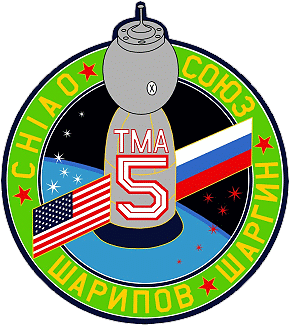 |
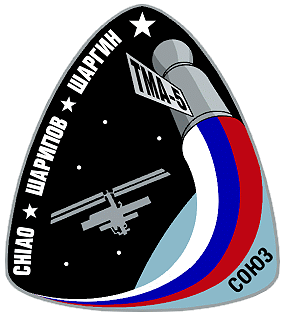 |
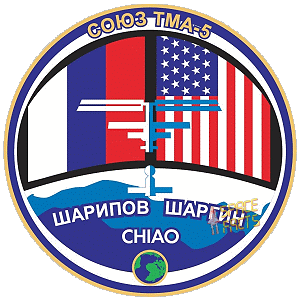 |
||
![]()
Launch, orbit and landing data
walkout photo |
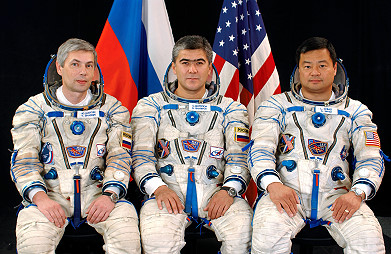 |
|||||||||||||||||||||||
alternative crew photo |
alternative crew photo |
|||||||||||||||||||||||
alternative crew photo |
alternative crew photo |
|||||||||||||||||||||||
alternative crew photo |
alternative crew photo |
|||||||||||||||||||||||
Crew
| No. | Surname | Given names | Position | Flight No. | Duration | Orbits | |
| 1 | Sharipov | Salizhan Shakirovich | Commander | 2 | 192d 19h 01m 59s | 3032 | |
| 2 | Chiao | Leroy | Flight Engineer | 4 | 192d 19h 01m 59s | 3032 | |
| 3 | Shargin | Yuri Georgiyevich | Flight Engineer | 1 | 9d 21h 28m 41s | 155 |
Crew seating arrangement
|
 |
|
||||||||||||||||
Backup Crew
|
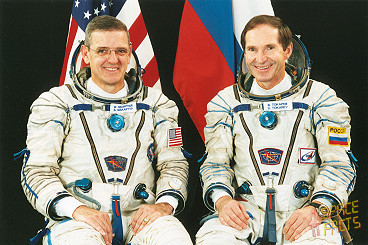 |
|||||||||||||||
Hardware
| Launch vehicle: | Soyuz-FG (No. 32M132S Zh15000-012) |
| Spacecraft: | Soyuz TMA-5 (TMA No. 215) |
Flight
|
Launch from the Baikonur Cosmodrome and
landing 93 km north of Arkalyk. The mission carried out the ISS Expedition 10. They were called a "caretaker" crew. Following a two-day solo flight Soyuz TMA-5 docked to ISS on October 16, 2004. Salizhan Sharipov and Leroy Chiao replaced the Expedition 9 crew. 17 experiments from the NASA were planned, including the first work with the DAFT experiment and completing the ISSI. This experiment was conducted during Space Station Expedition 7 and/or Expedition 8. Notable accomplishments included replacing critical hardware in the Quest Joint Airlock; repairing U.S. spacesuits; and submitting a scientific research paper on ultrasound use in space. Leroy Chiao was also the first astronaut to vote in a U.S. Presidential election from space. Progress M-51 was launched at 22:19:34 UTC on December 23, 2004. The spacecraft docked with the Aft port of the Zvezda module at 23:57:45 UTC on December 25, 2004. Progress M-51 carried supplies to the International Space Station, including food, water and oxygen for the crew and equipment for conducting scientific research. The freighter remained docked for two months before undocking at 16:06:30 UTC on February 27, 2005 to make way for Progress M-52. Between undocking and deorbit, Progress M-51 was used for a series of tests. It was deorbited at 16:17:00 UTC on March 09, 2005. The spacecraft burned up in the atmosphere over the Pacific Ocean, with any remaining debris landing in the ocean at around 17:03:11 UTC. The first EVA by Leroy Chiao and Salizhan Sharipov was performed on January 26, 2005 (5h 28m) to install a work platform on the hull of the command module, to mount the European commercial experiment Rokviss, to relocate the Japanese space exposure experiment package and to install a Russian biological experiment. Progress M-52 was launched at 19:09:18 UTC on February 28, 2005. The spacecraft docked with the Aft port of the Zvezda module at 20:10:08 UTC on March 02, 2005. Progress M-52 carried supplies to the International Space Station, including food, water and oxygen for the crew and equipment for conducting scientific research. It also carried the TNS-0 nanosatellite, which was deployed from the ISS on March 28, 2005 at 08:30 UTC. The freighter remained docked for three and a half months before undocking at 20:16:10 UTC on June 15, 2005 to make way for Progress M-53. It was deorbited at 23:16:00 UTC on June 15, 2005. The spacecraft burned up in the atmosphere over the Pacific Ocean, with any remaining debris landing in the ocean at around 00:02:41 UTC on June 16, 2005. The second and final EVA by Leroy Chiao and Salizhan Sharipov occurred on March 28, 2005 (4h 30m) to install three communications antennas for the ATV (Automated Transfer Vehicle) and a GPS (Global Positioning System) antenna, Salizhan Sharipov manually deployed a Russian experiment, tossing a small science satellite called "Nanosatellite" into orbit. The Soyuz spacecraft is composed of three elements attached end-to-end - the Orbital Module, the Descent Module and the Instrumentation/Propulsion Module. The crew occupied the central element, the Descent Module. The other two modules are jettisoned prior to re-entry. They burn up in the atmosphere, so only the Descent Module returned to Earth. The deorbit burn lasted 259.2 seconds. Having shed two-thirds of its mass, the Soyuz reached Entry Interface - a point 400,000 feet (121.9 kilometers) above the Earth, where friction due to the thickening atmosphere began to heat its outer surfaces. With only 23 minutes left before it lands on the grassy plains of central Asia, attention in the module turned to slowing its rate of descent. Eight minutes later, the spacecraft was streaking through the sky at a rate of 755 feet (230 meters) per second. Before it touched down, its speed slowed to only 5 feet (1.5 meter) per second, and it lands at an even lower speed than that. Several onboard features ensure that the vehicle and crew land safely and in relative comfort. Four parachutes, deployed 15 minutes before landing, dramatically slowed the vehicle's rate of descent. Two pilot parachutes were the first to be released, and a drogue chute attached to the second one followed immediately after. The drogue, measuring 24 square meters (258 square feet) in area, slowed the rate of descent from 755 feet (230 meters) per second to 262 feet (80 meters) per second. The main parachute was the last to emerge. It is the largest chute, with a surface area of 10,764 square feet (1,000 square meters). Its harnesses shifted the vehicle's attitude to a 30-degree angle relative to the ground, dissipating heat, and then shifted it again to a straight vertical descent prior to landing. The main chute slowed the Soyuz to a descent rate of only 24 feet (7.3 meters) per second, which is still too fast for a comfortable landing. One second before touchdown, two sets of three small engines on the bottom of the vehicle fired, slowing the vehicle to soften the landing. During the stay on board of the ISS the crew of Expedition 10 carried out the following scientific experiments: ADUM (Advanced Diagnostic Ultrasound in Microgravity), ARISS (Amateur Radio on the International Space Station), BCAT-3-4-CP (Binary Colloidal Alloy Test - 3 and 4: Critical Point), BCAT-3-SC (Binary Colloidal Alloy Test - 3: Surface Crystallization), Biodegradation (Initial stage of Biodegradation and Biodeterioration in Space), Bioekologia (Generation of High Efficiency of Microorganisms for the Production of Preparations of Biodegradable Oil, Organophosphorus Material, Measures for the Protection of Plants, as well as, of Exopolysaddharides Uses in the Petroleum Industry), Bioemulsia (Research and Development of a Self-Contained Reactor of the Shielded Type For Production of Biomass of Microorganisms and Biologically Active Substances), Biopsy (Effect of Prolonged Space Flight on Human Skeletal Muscle), Biorisk (Influence of Factors of the Space Environment on the Condition of the System of Microorganisms-Hosts Relating to the Problem of Environmental Safety of Flight Techniques and Planetary Quarantine), Biotest (Biochemical Status of Humans in Long Duration Space Flight), BOP (Bone Proteomics), Brados (Acquisition of Data About the Radiological, Electromagnetic and Different Physical Environments on Board ISS, and Their Effects on the Safety of the Crew, Space Equipment and Materials), Cardio-ODNT (Dynamics of the Main Factors of Cardiac Function, of Central and Regional Circulation in Rest and During the Influence of Lower Body Negative Pressure), CBOSS-FDI (Cellular Biotechnology Operations Support Systems: Fluid Dynamics Investigation), CEO (Crew Earth Observations), Chromosome-1 (Chromosomal Aberrations in Blood Lymphocytes of Astronauts-1), Clinical Nutrition Assessment (Clinical Nutrition Assessment of ISS Astronauts, SMO-016E), Conjugation (Development of Methods for Designing New Recombinants Producing Strains of Bacteria in Space Flight), DAFT (Dust and Aerosol Measurement Feasibility Test), Diatomeya (Stability of Geographical Position and Configuration of Borders of Bioproductive Water Zones of the World Oceans, Observations by Orbition Station Crews), Diurez (Fluid and Electrolyte Metabolism and Hormonal Regulaltion of Fluid Volume), EarthKAM (Earth Knowledge Acquired by Middle School Students), Ekon (Experimental Survey on Evaluating the Possibility of Using th Russian Segment of ISS for Environmental Inspection of Work Areas of Various Facilities (Features)), Environmental Monitoring (Environmental Monitoring of the International Space Station), EPO-Demos (Education Payload Operation - Demonstrations), ETD (Eye Tracking Device), Farma (Characteristics of Pharmacological Responses (absorption, distribution and elimination of acetominophene) in Long Duration Space Flight), Fischer Rat Thyroid Low Serum 5 (Fischer Rat Thyroid Low Serum 5%), Gematologia (Morphofunctional Characteristic of Blood Cells and the Intensity of Erythropoiesis in Humans by the Influence of Factors of Space Flight), Identifikatsia (Identification of the Sources of Dynamic Loads on ISS), Inflight Education Downlinks (International Space Station Inflight Education Downlinks), Interleukin-K (Production of Hight Quality Crystals of Interleukin -1Alpha, -1Beta and Receptor of Antagonist of Interleukin-1), ISSI (In Space Soldering Investigation), ISS Acoustics (International Space Station Acoustic Measurement Program), JAXA-GCF (Japan Aerospace and Exploration Agency - Granada Crystallization Facility High Quality Protein Crystallization Project), Journals (Behavioral Issues Associated with isolation and Confinement: Review and Analysis of Astronaut Journals), Kromka (Verification of the Effectiveness of Devices for the Protection of the Exterior Surface of ISS from Contaminants Deposited by Pulsed Cycling of Liquid-Jet), Meteoroid (Recording Meteoroidal and Technogenic Particles on the External Surface of the Service Module of the Russian Segment of ISS), Mezhkletochnoe Vzaimodeistvie (Intercellular Interactions in Space Flight), MFMG (Miscible Fluids in Microgravity), Microspace (Microbial Life in Space: Response to Environmental Factors in a Space Vehicle), Mimetik-K (Crystalization of antigen Binding Fragment of Monoclonalical Antibody to Glucosaminilmuramildepeptide), MISSE-1 and 2 (Materials International Space Station Experiment - 1 and 2), Mobility (Promoting Sensorimotor Response Generalizability: A Countermeasure to Mitigate Locomotor Dysfunction After Long-Duration Space Flight), Molniya-SM (Investigation of Lightning Discharges in the Earth's Atmosphere and Lower Ionosphere), MOP (Motion Perception: Vestibular Adaptation to G-Transitions), OVAR (Off-Vertical Axis Rotation: Eye Movements and Motion Perception Induced By Off-Axis Rotation at Small Angles of Tilt After Spaceflight, DSO 499), PCG-STES-RGE (Protein Crystal Growth-Single Locker Thermal Enclosure System-Regulation of Gene Expression), PCG-STES-SA (Protein Crystal Growth-Single Locker Thermal Enclosure System-Science and Applications of Facility Hardware for Protein Crystal Growth), Pilot (Individual Characteristics of Psychophysiological Regulatory Status and Reliaility of Professional Activities of Cosmonauts in Long Duration Space Flight), Plasma Crystal (Dusty and Liquid Plasma Crystals in Conditions of Microgravity), Profilaktika (Mechanisms of Action and Influence, and Effectiveness of Various Methods of Phrophylaxis Directed Toward Prevention of Disturbances of the Human Locomotion System in Weightlessness), Prognoz (Development of a Method of Operational Prediction of Work Load on Crew Piloting Objectives), Pulse (Vegatative (Autonomic) Regulation of the Cardio-Respiratory System of Humans in Conditions of Weightlessness), Rastenia (Growth and Development of Higher Plants through Multiple Generations), Relaksatia (Processes of Relaxation in the Ultraviolet Band Spectrum by High Velocity Interaction of Exhaust Products on ISS), ROKVISS (Robotic Component Verification on the ISS: Verification of Lightweight Robotic Hinge Elements in Space), SEM (Space Experiment Module), SKR (Skorpion: Development and Acquisition of Multifunctional Control-Measurement Device for Controlling the Environment of Scientific Experiments Inside a Pressurized Station), SNFM (Serial Network Flow Monitor), Sprut-MBI (Determination of Intracellular and Extracellular Fluid Volume in Humans in Space Flight), SVS (CBC: Self-Propogating Hyperthermal Synthesis in Space), Toksichnost (Development of a Metod of Express Monitoring of Toxicity of Water in Space Flight), Uragan (Hurricane: Experimental Development of Groundbased System of Monitoring and Predicting the Progression of a Naturally Occurring Technogenic Catastrophe), Vaktsina-K (Structural Study of Protein Candidats in a Vaccine for AIDS on Earth and in Space). |
EVA data
| Name | Start | End | Duration | Mission | Airlock | Suit | |
| EVA | Chiao, Leroy | 26.01.2005, 07:41 UTC | 26.01.2005, 13:11 UTC | 5h 30m | ISS-10 | ISS - Pirs | Orlan-M No. 25 |
| EVA | Sharipov, Salizhan | 26.01.2005, 07:41 UTC | 26.01.2005, 13:11 UTC | 5h 30m | ISS-10 | ISS - Pirs | Orlan-M No. 27 |
| EVA | Chiao, Leroy | 28.03.2005, 06:25 UTC | 28.03.2005, 10:55 UTC | 4h 30m | ISS-10 | ISS - Pirs | Orlan-M No. 25 |
| EVA | Sharipov, Salizhan | 28.03.2005, 06:25 UTC | 28.03.2005, 10:55 UTC | 4h 30m | ISS-10 | ISS - Pirs | Orlan-M No. 27 |
Note
Relocations of Manned Spacecrafts
| Spacecraft | from | Undocking | Time UTC | to | Redocking | Time UTC |
| Soyuz TMA-5 | ISS - Pirs | 29.11.2004 | 09:31:58 | ISS - Zarya | 29.11.2004 | 09:52:46 |
Photos / Graphics
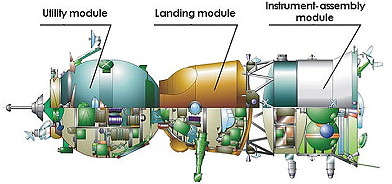 |
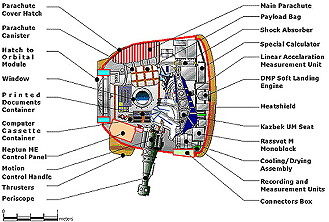 |
 |
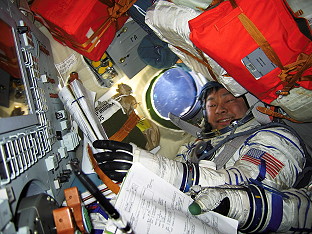 |
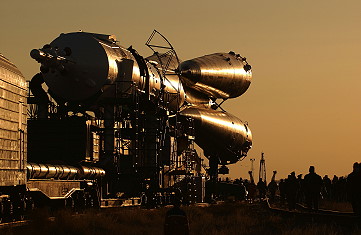 |
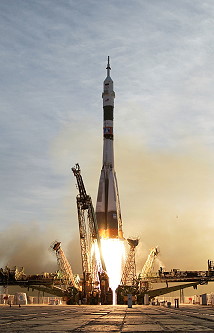 |
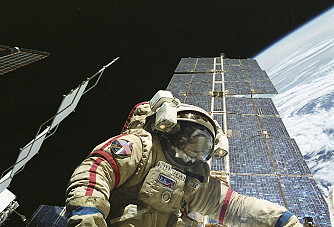 |
 |
 |
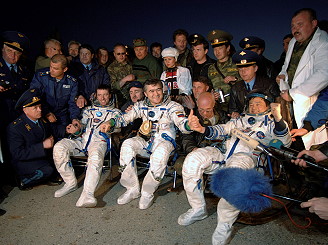 |
more EVA photos |
|
| © |  |
Last update on March 29, 2020.  |
 |